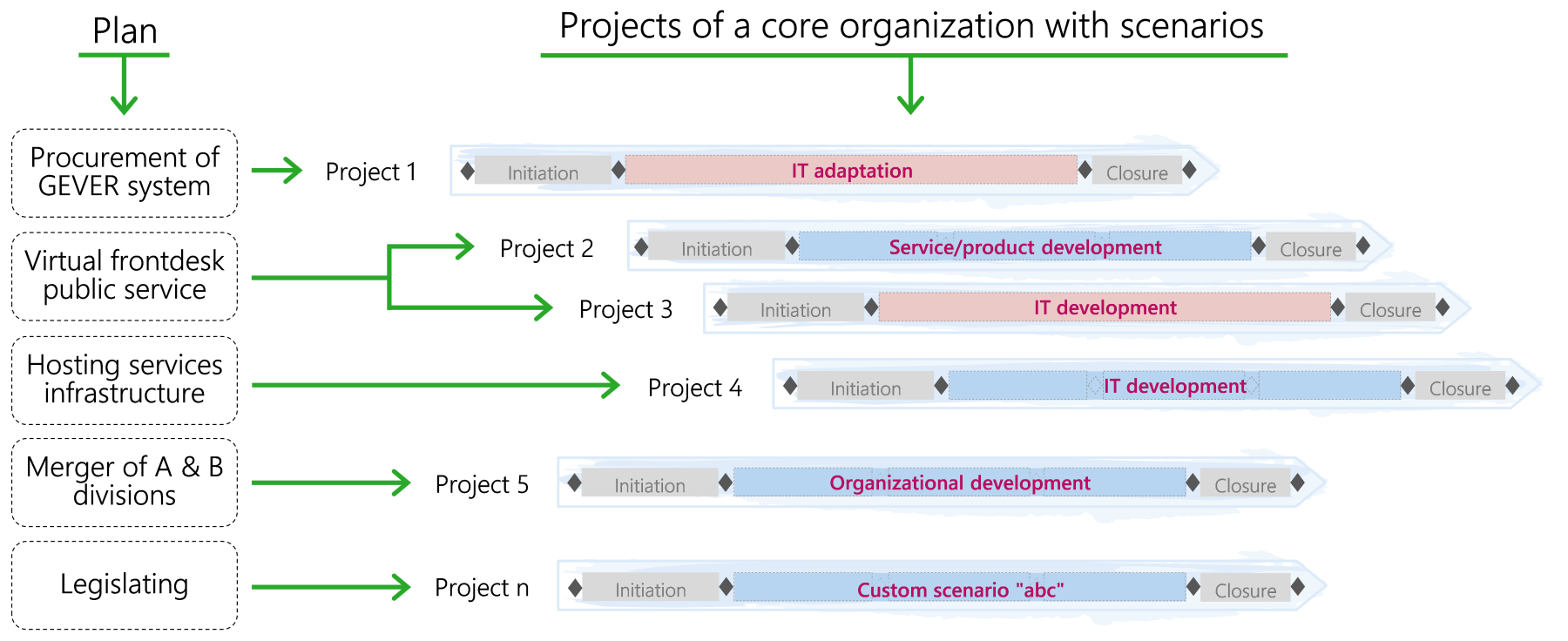HERMES-Projektmanagement-Methodenelemente
Phases
The HERMES phase model for projects forms the backbone of every project. It creates the conditions for the common understanding of all project participants. This is an important prerequisite for the successful cross-organizational handling of projects.
The phase model builds on the life cycle of a project. Figure 5 shows the HERMES project life cycle and the phase model for the traditional and agile approach; the initiation phase at the start and the closure phase at the end of the project are common to both approaches and include the solution development phases.

Figure 5: HERMES project life cycle with phase model for traditional and agile approach
Accordingly, projects are carried out in either five or three phases. The project starts with the initiation phase and ends with the closure phase. The initiation phase corresponds to a structured orientation for a focused project. It formulates which possible solutions exist and which path to take. The closure phase ends the project and defines the organizational and administrative transition from the project organization to the application organization.*
The phases included between initiation and closure are, in the traditional approach, the three phases of concept, implementation, and deployment, and in the agile approach, only execution.
If the core organization wants to explore a possible vision for a solution, it starts the project with the initiation phase, the outcomes of which also decide whether a traditional or agile approach should be taken for the development procedure. Within a single program, some of the projects may be carried out according to the traditional approach, others according to the agile approach.
Scenarios
Different projects are carried out within a core organization. Projects can vary considerably in terms of content and complexity. HERMES project management provides scenarios to satisfy the diversity of the projects. In the project, a scenario is determined for the development procedure included between initiation and closure, i.e. for the concept, implementation, and deployment phases in the traditional approach and for the execution phase in the agile approach.
A scenario is geared towards the implementation of projects of a specific nature. The scenario contains precisely those HERMES method components that are important for the development of the solution. Consequently, HERMES project management is quick and easy to use. By way of example, Figure 6 shows several plans of a core organization with the corresponding projects and scenarios.

Figure 6: Projects of a core organization with scenarios
In the initiation phase, the project manager selects the suitable solution option, along with the scenario suitable for the development procedure. Based on this, the project manager plans the specific procedure and the development of the solution. HERMES offers a selection of possible standard scenarios, such as for an organizational adjustment or for the development of a service/product.
HERMES users can adapt standard scenarios to the needs of their organization and create their own custom scenarios.
Modules
Modules are reusable building blocks assigned to phases for creating projects and scenarios. Thematically related outcomes and the tasks associated with them form a module (see Figure 7).

Figure 7: A module is composed of outcomes and tasks
The project manager can create additional modules and integrate them into individual scenarios.
Outcomes
As shown in Figure 8 with a selection of outcomes for each phase, outcomes are at the heart of HERMES project management.
There is an outcome description for each outcome. For all documents, there are document templates that describe the content in the outcomes in more detail. Tasks and roles are assigned to each outcome. The roles give an indication of the responsibilities for outcomes and of the involvement in the production of outcomes.
HERMES defines minimum required documents (outcomes) to meet project governance requirements.

Figure 8: Outcomes are at the heart of HERMES
Figure 9 shows that the phases start and end with milestones. These milestones correspond to quality gates when the outcomes and the procedure are decided. This also involves coordination with the strategic objectives and requirements of the core organization. Analogous to phase releases, optional interim releases may be approved under the agile approach, creating additional milestones.

Figure 9: Phases and releases with milestones as quality gates
All milestones are outcomes that mark decision points over the course of the project. Each decision task accordingly ends with a milestone. Depending on the module, there are different decisions and consequently also different further milestones.
Tasks
Tasks are used to develop outcomes. Thematically related outcomes together with their associated tasks form modules.
There is a task description for each task. It defines the general approach and the activities that are undertaken to produce the outcomes. The roles give an indication of the role to which the responsibility for a task is assigned.
Roles
HERMES project management distinguishes between the roles of the core organization and roles of the project organization, but it describes only the HERMES roles of the project organization. For each role, there is a role description with the responsibilities, powers, and required skills for the roles as well as their relationships. Each role is assigned to one of the hierarchy levels of steering, management, or execution. Different roles are defined which can be used as needed.
Partners in the project organization are users, creators, and operators. Each role is assigned to one or more partner groups.
Figure 10 shows a project organization with the minimum roles to be filled, highlighted in gray: project sponsor, project management, and user representative.

Figure 10: Minimum roles to be filled: project sponsor, project management, and user representative
Project management
HERMES project management (see Section A.2) is one of the three method components of the holistic HERMES method.